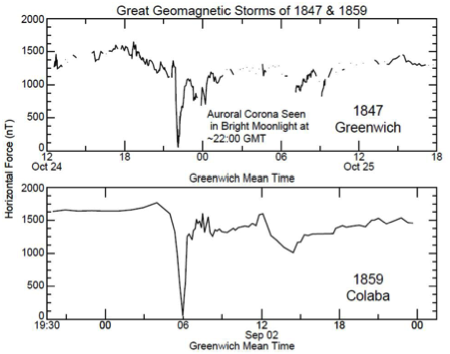The 1859 Space Weather Event Revisited
| Nugget | |
|---|---|
| Number: | 213 |
| 1st Author: | Ed Cliver |
| 2nd Author: | |
| Published: | November 25, 2013 |
| Next Nugget: | CMEs on young, solar-type stars |
| Previous Nugget: | Hard X-ray Footpoint Asymmetry |
Introduction
After more than 150 years, the space-weather event of 1859 associated with Carrington's name, continues to intrigue and inform us. It was relatively well observed by the tools available at that early time, which of course did not include any of the electronics that we take for granted today. The phenomena observed included the Carrington white-light flare itself, plus prompt and delayed geomagnetic effects that (mostly in retrospect) laid the foundation stones for space weather studies.
This "Carrington flare" is doubly distinguished both as the first reported solar flare and also because of its association with the largest geomagnetic disturbance yet recorded. It remains the exemplar and guide for us as regards extreme space-weather events.
Estimates of Event Magnitudes
In a recent paper [Ref. 1], we have reassessed the size of the 1859 flare and its consequences. Our best guesses are as follows: a GOES flare magnitude (soft X-ray classification) and total (flare radiation plus CME kinetic) energy of ~X45 and ~2 x 1033 erg, respectively (Figure 1); a >30 MeV proton fluence (F30) of ~1010 pr cm-2; and a minimum Dst index of ~ -900 nT. These estimates and those measured for the closest modern competitors in each category are shown in tabular form here:
Event GOES Energy F30 Dst
(erg) (pr cm-2) (nT)
SOL1859-09-01 X45 2.0 x 1033 1 x 1010 -900
SOL2003-10-28 X17 1.5 x 1033
SOL2003-11-04 X35 1.0 x 1033
SOL1972-08-04 5 x 109
SOL1921-05-14 -850
The Dst index is a measure of global variability during a magnetic storm. The estimated geomagnetic Dst index of -900 nT for the Carrington storm, reduced from a reported -1760 nT value based on Colaba (near Mumbai, India) observations, reflects direct [Ref. 2] and indirect (Figure 2) evidence that the Colaba reading included an auroral component.

In a related paper [Ref. 3] we question the recent attribution of the cosmogenic nuclide event of 775 AD [Ref. 4] to the Sun [Ref. 5]. Such a solar event would imply an F30 value of ~8 x 1010 pr cm-2 (approximately 10 times the value recorded during the three-month interval of sustained strong SEP activity from August-October 1989), a 1 GV proton fluence 45 times larger than that of the February 1956 ground level event, and flare with a GOES classification of X230 (1034 erg) flare.

Conclusion
The solar flare and terrestrial effects of the Carrington space-weather event of 1859 are still of great current interest, and the work described here is helping to place it in the context of recent observations. There is a caveat regarding the coincidence of first flare and greatest storm in the 1859 event. Hugh Hudson (personal communication, 2013) cautions that the first flare reported was bound to have been a whopper. That said, there is no guarantee that a big flare will produce a big magnetic storm, since its heliographic position and the orientation of the magnetic field in the accompanying CME are also crucially important for such effects. The 4 August 1972 flare had a CME with a shorter transit time to Earth than that of the 1859 event (14.6 hr vs. 17.5 hr) but the associated 1972 storm (Dst = -125 nT) does not rank near the top 25 of such events.
References
[1] "The 1859 space weather event revisited: limits of extreme activity"
[2] "Duration and extent of the great auroral storm of 1859"
[3] "On a solar origin for the cosmogenic nuclide event of 775 AD"
[4] "A signature of cosmic-ray increase in AD 774-775 from tree rings in Japan"